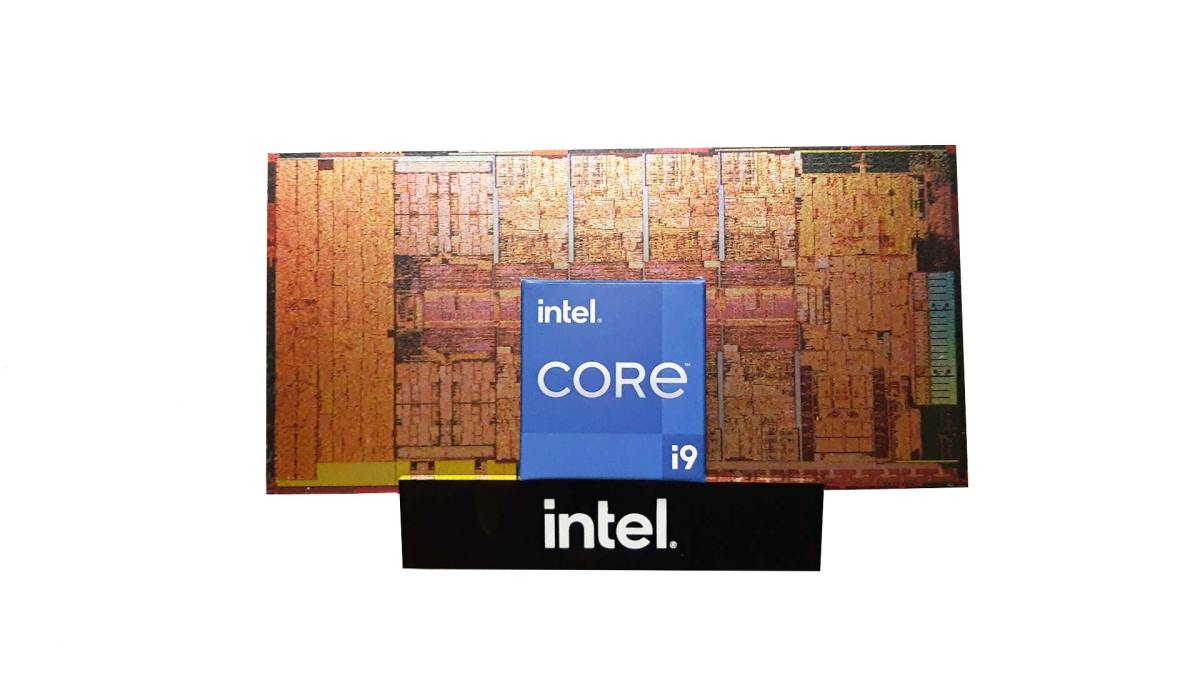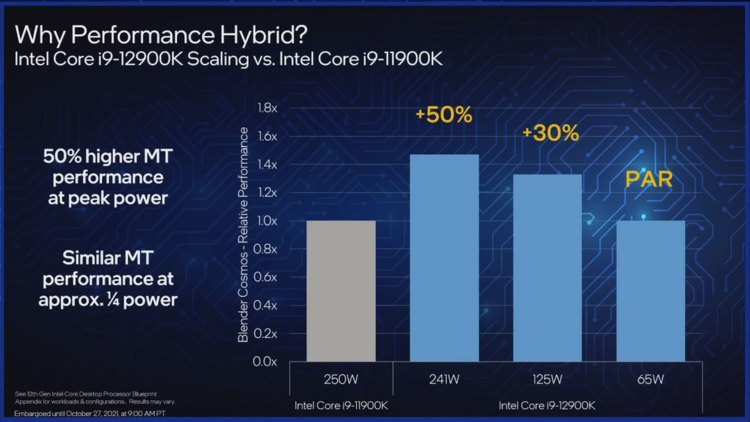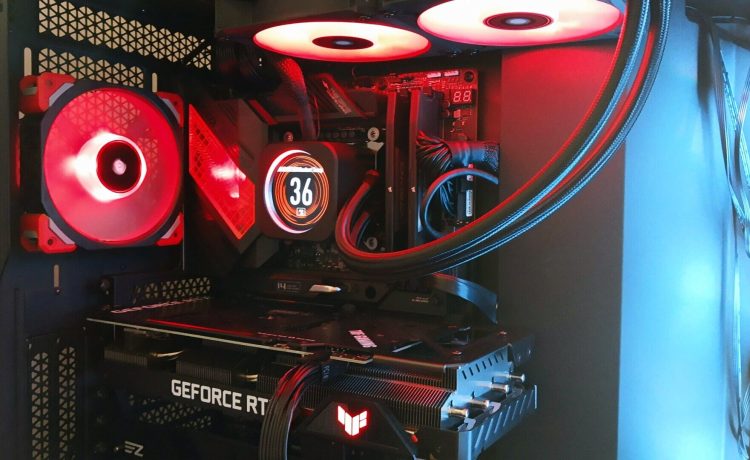After years of delays, Intel has finally moved on to a more advanced manufacturing node, bringing new levels of performance and efficiency to its desktop processors. As it would have it, this technological step forward also coincides with the introduction of Intel’s new Hybrid architecture that introduces a mix of big (P) and little (E) cores all on a single monolithic die. Codenamed “Alder Lake,” we’re looking at what is the most exciting new generation of processors from Team Blue in years. Intel seems to think so as well, because it sent us a 12900K to review for gaming performance, features, and value. And overall, we’re very impressed with it along with the rest of the 12th gen Intel CPUs.
As we carefully noted in our 11700K review, the last several generations of processors from Intel offered smaller performance improvements that often came at the cost of reduced power efficiency, though the revision of PCIe 4.0 support was welcome for Rocket Lake. Understandably, the last several Intel generations didn’t leave a whole lot for most gamers to get excited about if they already had a six-core CPU or better. AMD also managed to release the Ryzen 5000 Series, which brought fierce competition to Intel and has arguably been the better buy since its release in late 2020.
Intel’s 12th generation is all about forward momentum though, as Alder Lake offers a notable boost in single-threaded performance for gaming via its P-cores plus a huge jump in multi-threaded performance thanks to the new E-cores. Intel has boosted the efficiency of its existing powerful CPUs thanks to the node shrink to 10nm (known officially as the Intel 7 node) and essentially tacked on another integrated processor to handle background tasks and assist in applications that benefit from more cores. For gamers, Intel 12th generation CPUs are worth getting excited about. For content creators, these CPUs are absolute game changers.
And while there’s a lot to like about Intel’s entire new lineup of K-Series CPUs, you’re certainly not required to go out and buy one to enjoy most of today’s games at basic framerates. The i9 series has never really been about basic experiences though. As Intel’s latest flagship CPU, the 12900K has the potential to deliver high refresh experiences with startlingly impressive 1% and 0.1% framerate lows that result in silky smooth gameplay even while multi-tasking. In this review, we’ll run through the specs, features, some performance benchmarks, cost of entry, and then give a final recommendation for whether or not to buy Intel 12th gen, specifically the i9-12900K in this case.
- (Image credit: Intel).
Major differences with Intel 12th gen
As we already touched upon, the 8+8 Hybrid core configuration is one of the key differentiators for the latest i9 in comparison to previous generations. What this means is that Intel uses two different types of cores on a single CPU. The P-cores are designed for low latency, high performance applications, which pertains to gaming as far as we’re concerned. The E-cores are designed to handle applications with an emphasis on power efficiency, which relates to background processes and supporting apps like social apps, game launchers, RGB software, recording software, peripheral tuning, etc.
The P-cores are based on the Golden Cove architecture that also appeared on Rocket Lake 11th gen desktop CPUs, while the Gracemont E-cores are largely new. The P-cores are considered the “big” cores that feature hyper-threading and clock as high as you’d expect from previous generations, but the E-cores only have single threads and are smaller cores that clock lower and instead rely on spreading out workloads across multiple cores to handle tasks. Intel tacks on four of these E-cores for the i5 model, and up to eight of these on the i9. The result of the Hybrid design is a more efficient and better-performing processor than the traditional Intel approach with all P-cores. Coupled with the node shrink, Intel is now able to offer better performance without using significantly more power like was seen with the last several generations.
Overall, this Hybrid core design allows Intel 12th gen processors to allocate more resources towards producing higher framerates, while also keeping the system running smoothly overall. To help Windows send these tasks to the right cores, Intel also created its Thread Director scheduler, which was designed for Windows 11. You can still use Windows 10 with 12th gen Intel processors should you wish, but Intel has optimized the design to work with Microsoft’s “latest and greatest” OS.
Intel has also made several major steps forward in other areas for its 12th gen CPUs. DDR5 support is optional for those that want to be early adopters of the new spec, and Intel officially supports DDR5 up to 4800, while DDR4 support remains at 3200. Alder Lake CPUs on the Z690 platform also feature improved PCIe 4.0 support for the motherboard chipset and PCIe 5.0 support on the processor. The PCIe 5.0 support provided by the CPU extends to the top PCIe x16 slot and top M.2 x4 slot, so future generations of graphics cards and NVME SSDs will be fully compatible with Intel’s 12th gen CPUs. The Z690 chipset PCIe 4.0 support also allows for additional fast NVME SSDs to be installed. There are of course many more details you can dig into in terms of features and support, but these are the ones we decided to cover as a gaming focused site.
- (Image credit: Intel)
12900K specs at a glance
Aside from what we’ve already discussed, Intel also increased L2 and L3 cache throughout the lineup to improve performance. The i9-12900K features nearly double the cache than the previous generation. The new LGA 1700 socket is another thing to note, as a new Z690 motherboard is required for that reason among many others. The last major item of note is the power consumption. The 12900K officially tops out at 241W, which is slightly down from the previous generation i9. Power consumption is still high overall though.
| Process node | 10nm (Intel 7) |
| Socket | LGA 1700 |
| # of cores | 8 (P) + 8 (E) |
| # of threads | 24 |
| Base frequency | 3.2 GHz(P)/2.4GHz(E) |
| Max Turbo frequency | 5.2 |
| Cache | 30MB |
| TDP max | 241W |
| Memory support (recommended) | DDR4-3200/DDR5-4800 |
| PCIe specification | 5.0 and 4.0 |
| # of PCIe lanes | 20 |
| PCIe configuration | Up to 1×16+1×4, 2×8+4 |
Test system specs
Our test system consists of a high airflow case, with all fans and the liquid cooler running on the iCUE “Balanced” profiles to produce realistic performance benchmarks for average users. For our testing, we used Windows 11 per Intel’s guidance to coincide with the Thread Director technology that improves utilization of the Hybrid core design. We tested the new OS and found it to be relatively stable and similar in performance to Windows 10, so we elected to use it for this review. At the time of writing, the system also uses the latest BIOS build available from ASUS, Nvidia drivers, build of Windows 11, game/application builds, and updated firmware for related components.
For basic power and frequency settings, we allowed the ASUS ROG motherboard to deliver up to 241W to the CPU if requested, enabled the ASUS AI auto-OC tool, enabled XMP 3.0 on the Corsair Vengeance DDR5 memory, enabled Resizable BAR, set the Windows power plan to Performance, and selected “Prefer Max Performance” for the ASUS TUF RTX 3060 Ti OC in the Nvidia Control Panel. All other settings were set to default or automatic.
| Case | Corsair iCUE 5000X |
| CPU | Intel Core i9-12900K |
| Motherboard | ASUS ROG Z690 Strix-E Wifi |
| Memory | Corsair Vengeance DDR5 4800 64 GB |
| Graphics card | ASUS TUF RTX 3060 Ti OC 8GB |
| PSU | be quiet! Pure Power 11 FM 750W |
| Storage | WD Blue SATA SSD (OS), WD Black SN750 PCIe 3.0 SSD, Samsung 870 QVO SATA SSD |
| CPU cooler | Corsair H100i Elite LCD 240mm CLC (with Thermal Grizzly Kryonaut thermal paste) |
Software can also easily skew performance data, so we’ve organized a basic profile of what our test system looks like. It’s a daily use system, but we were careful to close all unnecessary programs before gathering data. We intentionally left a few common gaming applications and background processes running though to simulate real use cases. These include the critical Windows 11 applications, a single tab instance of Google Chrome, Corsair iCUE, Adobe Creative Cloud, ASUS Armoury Crate Lite, the necessary associated game launcher, and Discord.
We also have some additional notes about the performance metrics we gathered. We acknowledge that the RTX 3060 Ti GPU is the clear bottleneck in this system, but due to the ongoing graphics card shortages, we were unable to acquire anything more high end. We’ve used DLSS in some of our benchmarks to compensate for this limitation, which allowed us to push the 12900K harder in several titles. Peripheral polling rates can also affect performance. For the majority of our tests, we used standard 1,000Hz polling rates and reserved hyper-polling for a specific section of the review which is noted under “gaming and multi-tasking.” Additionally, we intended to use a CLC with a 360mm radiator for cooling, but again ran into availability issues. The 240mm radiator proved adequate for gaming on this system though.
Data is collected with in-game benchmarks, HWMonitor Pro, and RivaTuner through MSI Afterburner. All test data is gathered after 10 minute “heat soak” periods to reflect realistic long gaming sessions.
- Introduction, features, and specs
- Frequencies, power consumption, and temperatures
- Gaming performance and multi-tasking
- Pricing and conclusion











Published: Jan 7, 2022 08:00 am